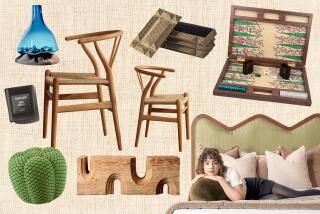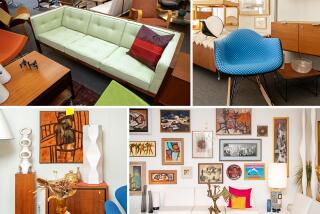Hope Chest Has Different Purpose
- Share via
The hope chest of the past, also called a wedding or dower chest, is still a popular piece of furniture, although it is no longer used in the traditional way.
In 17th and 18th century America, a hope chest was given to a young girl. During her teenage years, she wove fabrics, made quilts, embroidered towels and collected all of the household linens she would need in her home when she married.
Textiles were among the most valuable possessions in an 18th century home. The wedding chest went with the bride to her new home. The linens were taken out and used, and the empty chest was filled with family records, jewelry, special-occasion clothes or other items that should be stored.
In the early 1900s, the cedar chest became popular. Lane Co. made chests that stored woolens in a moth-free space. The chests were marketed as “hope” chests, symbols of romance and marriage.
Today, all sorts of chests are back in demand. Copies of early painted Pennsylvania chests, simple wooden chests or even chests with upholstered lids are being made. The chest is used for storage and as a seat and often kept at the foot of the bed.
*
Question: Sometime around 1930, when I was 8 or 9 years old, I received a Marx wind-up tractor for Christmas. I still have the toy, and it still works, but it’s missing its original driver and rubber wheel treads. The tractor is marked “Louis Marx & Co., N.Y.” It is 12 inches long and made of a silver-colored metal with red wheels. What is the tractor worth?
*
Answer: Your nickel-plated toy tractor was introduced by Marx, the famous toy manufacturer, in 1931. It originally came with a driver and tractor attachments, like a sweeper, plow and metal wagon. If you had the driver and the attachments, your tractor would sell for $125 to $275, depending on its condition.
*
Q: I grew up with two poodles in the 1950s. Every Christmas I received a little poodle figurine. I now have 10 of these figurines. Most of them are pink or white, and all are decorated with bunches of poodle “hair.” How was the hair made? What are the figurines worth?
*
A: Poodles were “in” in the 1950s. They found their way onto skirts, towels, drapes, eyeglass cases and even kitchen canisters. California and Japanese potteries churned out ceramic poodle figurines with “spaghetti” hair.
The term “spaghetti” refers to an old technique potters used to make strands of clay by using a sieve or press. Potters would press wet clay (slip) through the sieve. They would then wind the strands of clay around and pile them on the wet molded base.
If the designer cut the strands short, the hair was called “slaw” or “coconut.” Collectors of ceramic poodles pay $50 and up for rare, large, well-made poodles.
*
Q: Among my deceased father’s cache of old electronic gizmos is a small but heavy portable Philco TV set. The 2-inch screen is behind a sun visor that lifts up. It fits in a brown leather case with a carrying handle. Do you have any idea when this television was made and if people collect old TV sets?
*
A: Your father’s Philco “Safari” TV set, Model No. H2010, was America’s very first solid-state transistor TV set. It was sold with either a black or cowhide-colored case. The solid-state technology that was used to produce the set was a breakthrough, but the set weighed 15 pounds and cost a hefty $250. It came with a 20-usage rechargeable battery that gave about four hours of viewing per charge. Your father’s set is probably the most collectible of all early transistor TV sets. It would sell for more than $200.
*
Q: What is a “cultured” pearl? Is it a real pearl or a fake?
*
A: Cultured pearls are real pearls, meaning they grew inside the shells of living mollusks, usually oysters. But cultured pearls are not “natural” pearls. They are cultivated in a controlled environment.
A foreign substance, like a tiny bead or interior shell piece, is inserted inside the oyster. It is irritating, so the oyster secretes a coating to cover the rough bead.
Natural pearls are made when a foreign substance accidentally makes its way inside a mollusk’s shell. Simulated pearls are not real. They are made of glass or plastic and covered with a chemical coating.
*
Q: I purchased four glass apothecary bottles that range in height from 6 to 12 inches. The original stoppers and Latin-language labels are still intact. Can you tell me the age and value?
*
A: Apothecary bottles like yours were used in the United States about the middle of the 1800s. The labels were in Latin because it was the universal language of doctors and pharmacists. Values of 19th century glass apothecary bottles can range from about $200 to more than $1,000. Price depends on the color, size, condition and rarity of the bottle.
For a listing of helpful books and publications, include a self-addressed, stamped (55 cents) envelope to Kovels, Los Angeles Times, King Features Syndicate, 235 E. 45th St., New York, NY 10017.
(BEGIN TEXT OF INFOBOX / INFOGRAPHIC)
Current Prices
Current prices are recorded from antique shows, flea markets, sales and auctions throughout the United States. Prices vary in different locations because of local economic conditions.
* Meriden Homelectrics coffeepot, metal, the Manning-Bowman Company, 1910-25, 11 inches, $30.
* Franciscan glass salad bowl, Apple pattern, 9 by 4 inches, original box, $40.
* Mrs. Beeton’s Cookery Book, New & Revised Edition, publisher Ward, Lock & Co., Limited, London & Melbourne, 1923, 386 pages, $75.
* Stoneware jug, brown and white, marked “A. Hatke & Co., Distillers of Fine Whiskeys, Richmond, Va., est. 1867,” One gallon, $160.
* Japanese bamboo-and-pearl walking stick with carved shaft, geisha girl and cherry blossom, crook handle, circa 1912, 35 1/2 inches, $185.
* Western Industrial table lamp, circular marble base with curving tubular brass stem, yellow, green and orange pear-shaped shades, 25 inches, $205.
* Jacquard four-color coverlet, corners read “Elizabeth Town/S.H. 1836,” bird-and-tree border, red, blue, white and gold, 76 by 70 inches, $330.
* Kestner No. 164 doll, bisque head, open mouth, brown sleep eyes, dimple, fully jointed, stamped, 17 inches, $415.
* Victorian walnut ladies desk, French style, kidney-shaped, pierced ormolu gallery, one long drawer, two bowed drawers, fluted legs, $1,870.
* Tiffany sterling compote, oval form with handles, vermeil interior and applied lobsters on sides, marked, 1870-75, 13 by 6 inches, $6,260.
More to Read
Inside the business of entertainment
The Wide Shot brings you news, analysis and insights on everything from streaming wars to production — and what it all means for the future.
You may occasionally receive promotional content from the Los Angeles Times.










